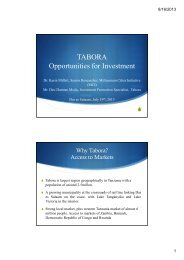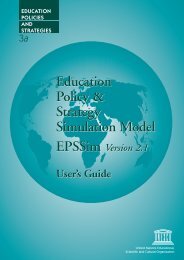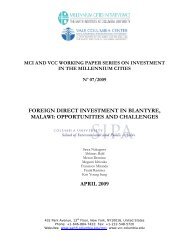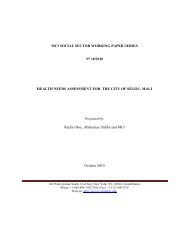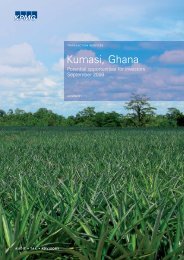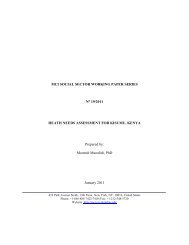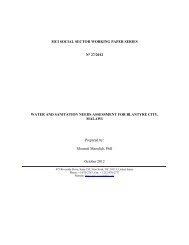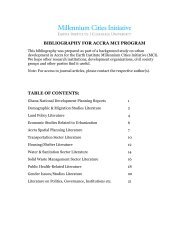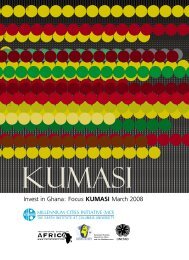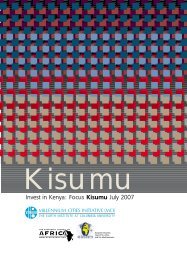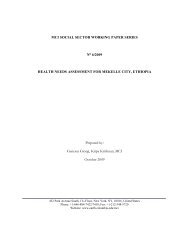Transport-Land Use Research Study - Millennium Cities Initiative ...
Transport-Land Use Research Study - Millennium Cities Initiative ...
Transport-Land Use Research Study - Millennium Cities Initiative ...
Create successful ePaper yourself
Turn your PDF publications into a flip-book with our unique Google optimized e-Paper software.
The Accra Pilot BRT: <strong>Transport</strong>-<strong>Land</strong> <strong>Use</strong> <strong>Research</strong> <strong>Study</strong><br />
<strong>Millennium</strong> <strong>Cities</strong> <strong>Initiative</strong> and Accra Metropolitan Assembly<br />
century. The omnibus emerged as a leading form of motorised urban transport, even in cities, which had<br />
extensive rail, metro and tram networks.<br />
The omnibus service was characterised by large buses, which operated on networks of scheduled routes<br />
centred on the urban core with harmonised fares. Operations were based on the efficiency of production,<br />
including standardised vehicle types and parts, depot-based maintenance, organised trained labour and<br />
hierarchical management. The underlying fact is that large-scale centralised bus operations provided an<br />
efficient, effective, profitable means of transportation in cities that did not yet experience high levels of car<br />
ownership and its associated congestion (Finn, 2008).<br />
Presently, public transport supply in the city is dominated by the private sector which runs the famous<br />
minibus public transportation vehicles (locally referred to as tro-tro) and taxis whose operations gained<br />
prominence under Ghana‟s Economic Recovery Programme (ERP) in the early 1980s, when the state<br />
divested its public investment in bus operations to the private sector (Fouracre et al., 1994). In 1989, due to a<br />
legal restriction that banned all minibuses (up to 23 seats) from operating on routes beyond 50 km from the<br />
city, an estimated 10,800 minibuses were converted to urban operations, further increasing transport<br />
provision in the city (Ofosu-Dorte, 1992).<br />
The dominant entity is the Ghana Private Road <strong>Transport</strong> Union (GPRTU), which organises more than 80%<br />
of the tro-tro sector, as well as being very active in taxi and shared taxi provision. Thanks to alignment with<br />
the prevailing political faction in the 1980s, GPRTU was granted permissions in organising terminals and<br />
services. The balance of the sector consists of a mix of associations (Cooperative, PROTOA) and some bus<br />
companies (e.g. Agate) which are affiliated under the Ghana Road <strong>Transport</strong> Coordinating Council (GRTCC)<br />
(Finn, 2008). There is no entry limit into the transport market. The <strong>Transport</strong> Operations Unit of the AMA is<br />
responsible for the management and control of parking, and operation of lorry parks and bus terminals. Of<br />
late, in practice, the management of lorry parks and terminals has been delegated to the transport operator<br />
unions (GIMSR, 1996).<br />
The emergence and scale of private sector transport providers to Accra‟s transport supply is significant. At<br />
the time when the state-owned OSA was crumbling against the backdrop of rising economic losses and<br />
overwhelming operational difficulties and stiff competition from the private sector, the contribution of the<br />
City Express Service (CES) was abysmal. In January 1992, for instance, the CES‟ urban mileage was less<br />
than 10 % of the entire city (Fouracre et al., 1994). Added to the preceding point is the inability of the OSA<br />
and CES buses to raise the quality of their services to levels that would enable them to compete with the<br />
private sector in spite of huge government subsidies received over the years (OSA, 1990; Abane, 1992).<br />
In view of the disparities between the huge levels of demand and limited supply of transport service during<br />
this era, the private sector transport providers revamped the transport service delivery and made it readily<br />
available, accessible and affordable Available figures indicate that in 2004 alone, 1.3 million passengers<br />
- 46 -



